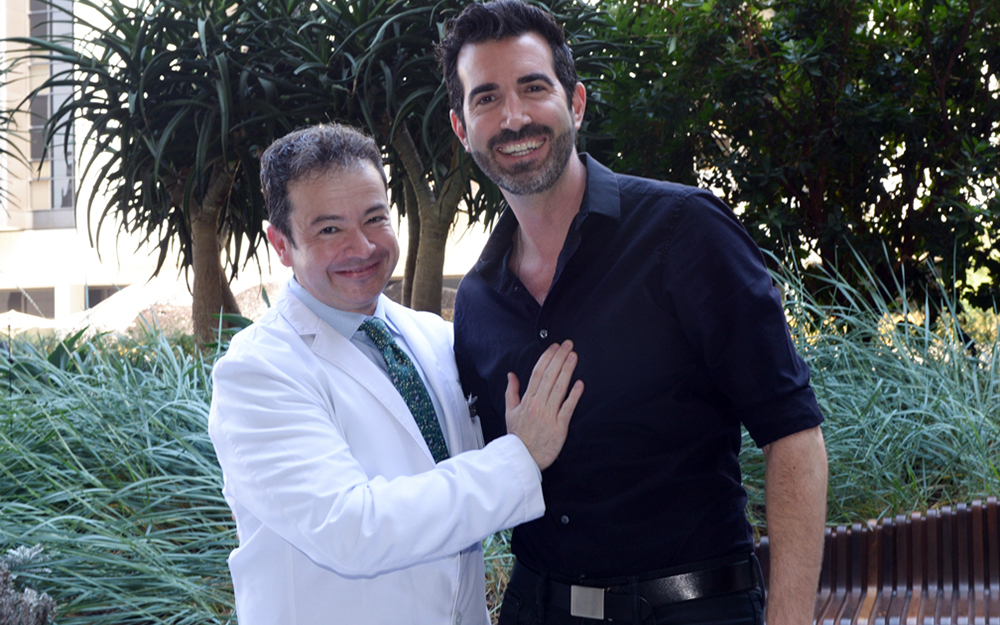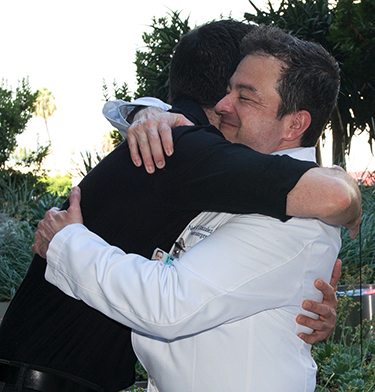Cedars-Sinai Blog
Timeline of a Stroke: Gabriel's Story
Oct 10, 2017 Cedars-Sinai Staff

Nestor Gonzalez, MD, (left) and Gabriel Goldberg mark the one-year anniversary of a lifesaving neurological procedure that restored the former Cedars-Sinai patient to good health after suffering a severe stroke.
A little over a year ago, Gabriel Goldberg's life came down to a few hours at Cedars-Sinai.
Today, the energetic 44-year-old photographer looks like the picture of health. But one Labor Day weekend, while at the gym, he nearly lost everything.
"This was like getting eaten by a shark. You're aware of what's happening but you can't stop it."
Shortly into his workout, Gabriel started feeling dizzy, experiencing weakness on his right side, and struggling to speak. Moments later, he felt sharp, hot pinpricks on his face. The room flipped sideways.
When an ambulance arrived, paramedics quickly determined that Gabriel was having a stroke. They rushed to Cedars-Sinai, home to one of three comprehensive stroke programs in Southern California.
Gabriel was no stranger to medical challenges. He was born with a congenital heart condition that he has managed with a healthy lifestyle, medications, and corrective surgeries—including one as an adult to install an artificial heart valve. But nothing prepared him for what happened that day at the gym.
"I had open heart surgery when I was 31," says Gabriel. "I was ready for that. But this was like getting eaten by a shark. You're aware of what's happening but you can't stop it."
Gabriel is one of about 1,200 patients treated each year by the Cedars-Sinai Stroke Program. Stroke patients like Gabriel must receive medical care within a tight window—about 6 hours—for the best chance of survival and preserving quality of life.
Take a peek inside the rapid response that saved Gabriel's life in this timeline of his stroke, from first symptoms to discharge from the hospital just 4 days later.
Read: Surviving a Brain Attack
Gabriel's stroke timeline

Dr. Nestor Gonzalez reunites with stroke Patient Gabriel Goldberg.
Sunday, Sept. 4, 2016
- Gabriel is lifting weights when his symptoms appear. He dials a friend, who immediately calls for an ambulance. By the time the conversation is over, Gabriel lacks the strength to hold the phone.
- Paramedics arrive. They note Gabriel is "foaming at the mouth," and that his eyes are moving in different directions.
- Cedars-Sinai receives a "Code Brain" page, which mobilizes a stroke specialist team in the Emergency Department to prepare for an acute stroke patient.
- Gabriel arrives at the Emergency Department.
- A battery of medical tests is immediately performed to assess Gabriel's condition and to start developing a strategy. "There were seven or eight doctors and nurses yelling all around me," says Gabriel. "They kept asking me, 'What's your name? Who is the president? How old are you?'"
- A CT scan is performed and shows no evidence of hemorrhage. After the test, a nurse asks Gabriel what his biggest fear is. His speech marred by the stroke, he still manages to reply: not being able to walk, talk, or shoot photographs again.
- Gabriel begins receiving a tissue plasminogen activator, a clot-busting drug administered intravenously that is commonly referred to as tPA. He is initially given 10% of the dose, then the remainder over the next hour.
- A CT angiogram of the head and neck is performed. Results show significant blockages of the distal basilar artery, which supplies the brain with oxygen-rich blood.
- The tPA intravenous drip is completed. "It steadied me," Gabriel recalls. "At least my symptoms weren't getting worse at this point." The tPA is very effective at dissolving smaller clots, but often fails to break up larger ones like Gabriel's.
- It is increasingly clear that Gabriel will have to undergo a mechanical thrombectomy. This highly delicate procedure utilizes a tiny stent retriever to remove blood clots from the brain. "It's extremely difficult," says registered nurse Laurie Paletz, stroke program coordinator in the Department of Neurology. "It's like threading a needle where the thread keeps turning and circles around itself. It requires advanced neurosurgical training and sophisticated operating skills."
- Nestor R. Gonzalez and his team prepare for surgery. "Time is brain," Dr. Gonzalez says of treating stroke patients. "You want to intervene as soon as possible for the best outcomes. Time is critical."
- The procedure begins with the puncture of Gabriel's right femoral artery. A catheter is threaded through the artery from his groin up to the blockage in his brain.
- The stent retriever opens and grabs three clots in Gabriel's brain. Tests confirm blood flow has been fully restored to the brain.
- After waking up in the Neuro Intensive Care Unit, Gabriel is asked for his name. He replies without stumbling. "I thought, 'That's what I'm supposed to sound like,'" he says. "It was a huge relief. It was overwhelming."
Monday, Sept. 5
- Less than 12 hours after he suffered a life-threatening stroke, Gabriel connects via FaceTime with his parents, who live in Connecticut, and is able to explain his condition to them in a clear voice.
Tuesday, Sept. 6
- Gabriel is transferred from the ICU to a non-critical care unit.
Thursday, Sept. 8
- Gabriel is discharged from Cedars-Sinai.
Stroke survivors are often left with lasting brain damage, but Gabriel had none. Four weeks later, he returned to work and resumed his previous activities.
"The biggest thing I've realized is that Dr. Gonzalez didn't just save my life," says Gabriel. "He saved my quality of life."


